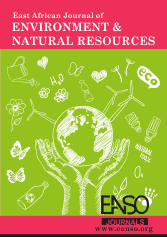Climatic Variability and Change on Biodiversity, Freshwater Wetland Ecosystem Service and Livelihoods in Zanzibar
Abstract
Worldwide, freshwater wetland ecosystems are very important for maintaining the ecological stability of natural ecosystems as well as enhancing the human well-being of the surrounding community. This study was aimed at assessing the impacts of climatic variability and change on freshwater wetland ecosystem services and associated livelihoods in Zanzibar. The Islands are extremely vulnerable to climate change; However, a limited number of studies have been conducted on the possible effects of climate change on the wetlands. The study was carried out in eight wetland areas, four from Pemba, which include Machopozoni, Kangani, Bopwe, Shidi, and Tibirinzi, and four from Unguja Island, which include Mwera, Matetema, Kaburi kikombe and Mtwango. A purposive sampling technique was used to identify representative wetlands for this study. A total of 160 households living in the area for more than ten years were randomly selected and surveyed in this study, making an average of 20 households per study site. A semi-structured questionnaire was designed to capture different socio-wetland activities, and a checklist was used to record observations. The results show that about 98% of women interviewed mentioned that they used wetland for farming rather than other activities, while 88% of men depend on wetland for food and employment, and 30% of all respondents mentioned the importance of wetland for agricultural production. 57% of respondents in Unguja mentioned that pollution of wetlands is due to pesticides, while in Pemba, it is 78%. In the present study, there is no proper strategy set by communities for the conservation of wetlands. There is a decline in animal and plant species, Poor use and handling of pesticides, community dependent on wetland. Developed a wetland conservation strategic plan in both languages (English and Kiswahili). To encourage stakeholders to support the implementation plan.
Downloads
References
Amler, E., Schmidt, M., & Menz, G. (2015). Definitions and mapping of East African wetlands: A review. Remote Sensing, 7(5), 5256-5282.
Bardecki, M. J. (1991). Wetlands and climate change: a speculative review. Canadian Water Resources Journal, 16(1), 9-22.
Bassi, N., Kumar, M. D., Sharma, A., & Pardha-Saradhi, P. (2014). Status of wetlands in India: A review of extent, ecosystem benefits, threats and management strategies. Journal of hydrology: Regional studies, 2, 1-19.
Beyene, H., & Banerjee, S. (2011). Assessment of the pollution status of the solid waste disposal site of Addis Ababa City with some selected trace elements, Ethiopia. World Applied Sciences Journal, 14(7), 1048-1057.
Bwathondi, P. O. J., & Ngoile, M. A. K. (1990). Environmental aspects of the utilization of aquatic resources. In a workshop on the National Conservation Strategy, Dodoma, Tanzania (pp. 12-17).
Carey, C., & Alexander, M. A. (2003). Climate change and amphibian declines: is there a link? Diversity and distributions, 9(2), 111-121.
Chakraborty, R., Talukdar, S., Basu, T., & Pal, S. (2018). Habitat identity crisis caused by the riparian wetland squeeze in Tangon River Basin, Barind Region, India. Spatial Information Research, 26, 507-516.
Chapin Iii, F. S., Zavaleta, E. S., Eviner, V. T., Naylor, R. L., Vitousek, P. M., Reynolds, H. L., & Díaz, S. (2000). Consequences of changing biodiversity. Nature, 405(6783), 234-242.
Cowardin, L. M. (1979). Classification of wetlands and deepwater habitats of the United States. US Department of the Interior Fish and Wildlife Service Office of Biological Services.
Dugan, P. (1990). Wetland conservation: A review of current issues and required action
Engle, V. D. (2011). Estimating the provision of ecosystem services by Gulf of Mexico coastal wetlands. Wetlands, 31(1), 179-193.
Desta, H., Lemma, B., & Fetene, A. (2012). Aspects of climate change and its associated impacts on wetland ecosystem functions: A review. Journal of American Science, 8(10), 582-596.
Hillman, J. C. (1993). Ethiopia: compendium of wildlife conservation information.
Isaiah Ochieng Abillah, Dr. Benson Mwangi, Prof. Richard Juma, Prof. Clifford Machogu. (2021). Gender Roles in Wetlands Conservation and Restoration in Murang’a County, Kenya. International Journal of Humanities and Social Science Invention (IJHSSI. Volume 10 Issue 6 Ser. I || June 2021 || PP 25-32. DOI: 10.35629/7722-1006012532
IUCN [International Union for Conservation of Nature]. (1998). The Ghodaghodi Tal conservation area: a community centered management plan. IUCN Nepal, Kathmandu, Nepal
Keddy, P. A. (2010). Wetland ecology: principles and conservation. Cambridge University Press.
Lamsal, P., & Bajracharya, S. (2025). Attitude towards working in rural areas after graduation among undergraduates from various programs at Chitwan Medical College, Nepal. Journal of Chitwan Medical College, 15(1), 7-17.
Lema, A. J. (1979). Crop water requirements and beneficial flood for the Rufiji Flood Plain agriculture. (No Title).
LRDC and ODA. (1987). Profile of Agricultural Potential in Tanzania. Land Resources
Development Centre (LRDC) and Overseas Development Assistance (ODA).Surbiton, UK. Unpublished report.
M E A. (2005). Millennium Ecosystem Assessment. Ecosystems and human well-being (Vol. 5, p. 563). Washington, DC: Island Press.
Mitsch, W. J., & Gosselink, J. G. (2000). Wetlands John Wiley & Sons. Inc., New York, New York.
Mortsch, L. D., & Quinn, F. H. (1996). Climate change scenarios for Great Lakes Basin ecosystem studies. Limnology and Oceanography, 41(5), 903-911.
Mwalyosi, R. B. (1990). Resource potentials of the Rufiji River basin, Tanzania. Ambio, 16-20.
NRC (1992). Restoration of Aquatic Ecosystems. National Academy Press, Washington, D.C.
Okonkwo, C. N. P., Kumar, L., & Taylor, S. (2015). The Niger Delta wetland ecosystem: What threatens it and why should we protect it? African journal of environmental science and technology, 9(5), 451-463.
Prasad, S. N., Ramachandra, T. V., Ahalya, N., Sengupta, T., Kumar, A., Tiwari, A. K., & Vijayan, L. (2002). Conservation of wetlands of India - a review. Tropical Ecology, 43(1), 173-186.
Rajasekhar M., Raju G.S., Raju R.S., Basha U.I (2018b). Data on artificial recharge sites identified by geospatial tools in semi-arid region of Anantapur District, Andhra Pradesh, India. Journal of Data in Brief. Volume 19, August 2018, Pg 462-474
Reddy, K., & DeLaune, R. D. (2003). Biogeochemistry of wetlands science and applications.
Semesi, A. (1990, January). Conservation and utilization of mangrove plants along Tanzania Coast. In National workshop on Plant Genetic Resources, Arusha, Tanzania.
Sharma, C. B., & Ghose, N. C. (1987). Pollution of the river Ganga by municipal waste: a case study from Patna. Journal Geological Society of India, 30(5), 369-385..
Stephenson, P. J., Ntiamoa-Baidu, Y., & Simaika, J. P. (2020). The use of traditional and modern tools for monitoring wetlands biodiversity in Africa: challenges and opportunities. Frontiers in Environmental Science, 8, 61.
Sun, Z., Sun, W., Tong, C., Zeng, C., Yu, X., & Mou, X. (2015). China's coastal wetlands: conservation history, implementation efforts, existing issues and strategies for future improvement. Environment International, 79, 25-41.
Turyasingura, B., Saturday, A., Hirwa, H., Fatima, S. M., Tabukeli, M. R., & Ayiga, N. (2022). Wetland conservation and management practices in Rubanda District, South-Western Uganda.
United States. Environmental Protection Agency. Office of Pesticide Programs. (2004). Overview of the ecological risk assessment process in the Office of Pesticide Programs, US Environmental Protection Agency endangered and threatened species effects determinations. DIANE Publishing.
Verry, E. S. (2018). Hydrological processes of natural, northern forested wetlands. In Northern Forested Wetlands Ecology and Management (pp. 163-188). Routledge.
VPO, (2014). Guidelines for sustainable management of wetlands. The United Republic of Tanzania.
Watkiss, P., Downing, T., Dyszynski, J., Pye, S., Savage, M., Goodwin, J., & Lynn, S. (2011). The economics of climate change in the United Republic of Tanzania. Global Climate Adaptation Partnership (GCAP).
Watkiss, P., Downing, T., Dyszynski, J., Pye, S., Savage, M., Goodwin, J., & Lynn, S. (2011). The economics of climate change in the United Republic of Tanzania. Global Climate Adaptation Partnership (GCAP).
Wolters, V., Bengtsson, J., & Zaitsev, A. S. (2006). Relationship among the species richness of different taxa. Ecology, 87(8), 1886-1895.
Copyright (c) 2025 Abdalla Ibrahim Ali

This work is licensed under a Creative Commons Attribution 4.0 International License.




























